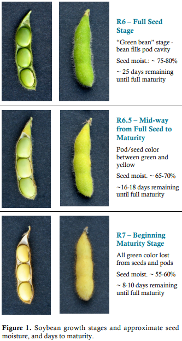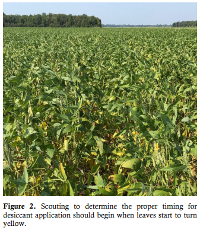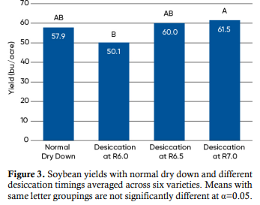Soybean desiccation
Soybean desiccation is not a new tool in other parts of the country, it has just not been used in Illinois with any frequency. In the past, harvest aids have been used to remedy problems that interfered with efficient soybean harvest e.g., green stems or excessive weeds. What is new is that more farmers are looking to desiccation in combination with earlier planting for an earlier harvest and reduced harvest loss and foreign materials (FM) that can lead to dockage. The potential yield advantage with earlier planting has been well-documented and 2021 saw many growers planting a considerable amount of their soybean acreage in April. Unfortunately, earlier planting can lead to increased incidence of green stem and delayed leaf senescence in some varieties. Foliar fungicides also contribute to plants retaining leaves after pods have reached maturity. Desiccation can help manage these concerns.
When Should I Desiccate?
Monitoring seed development, not leaf color, is key to making timely desiccation decisions. Ideally, desiccation should be done when seeds have reached physiological maturity at stage 6.5. This is indicated for indeterminate varieties when the membrane attaching the seed to the pod wall on the four uppermost main stem nodes begins to separate. Total plant pod weight is at its maximum and seeds will not gain more dry matter. Figure 1 shows seeds at various levels of development within growth stage 6: early R6 when membrane is still attached to the seed, R6.5 when membrane is no longer attached to the seed, and R7.0 which is slightly past the ideal timing for desiccation. To determine stage R6.5, start when leaf yellowing is first observed (Figure 2). Collect pods from top four nodes of plants randomly across field. Open pods and look for separation of beans from white membrane inside the pod. If separation has occurred for all pods collected, seeds are at physiological maturity and have reached maximum dry weight (Figure 3).


Research Results
A Pioneer field study was conducted in 2019 to evaluate soybean yield associated with different desiccation timings. Desiccation treatments consisted of Defol® 5 applied at R6.0, R6.5, or R7.0 growth stages. The study included six different soybean varieties and three replications. Defoliation at R6.5 and R7.0 provided the best yield results. Yield was significantly reduced with R6.0 defoliation compared to the R7.0 timing (Figure 3). Harvest was expedited by an average of 9 days with desiccation compared to normal dry down.

Desiccant Options
Commonly used desiccants in soybeans are paraquat (Gramoxone®), saflufenacil (Sharpen®), and sodium chlorate (Defol® 5). Each product label specifies a pre-harvest interval (PHI), which is the minimum amount of time that must elapse from application to soybean harvest. Of these, paraquat has the longest PHI of 15 days and requires the most precise timing to allow for the preharvest interval (PHI) to elapse before pods become too dry and shatter.
Soybean desiccation can be a useful tool to improve soybean harvest efficiency. It can allow use of earlier planting and, in some cases, even the use of earlier-maturing varieties. However, desiccants should always be applied at the appropriate soybean growth stage (R6.5) to reduce potential yield loss while at the same time allowing for the appropriate pre-harvest interval. Always read and follow label instructions.




 and then
and then